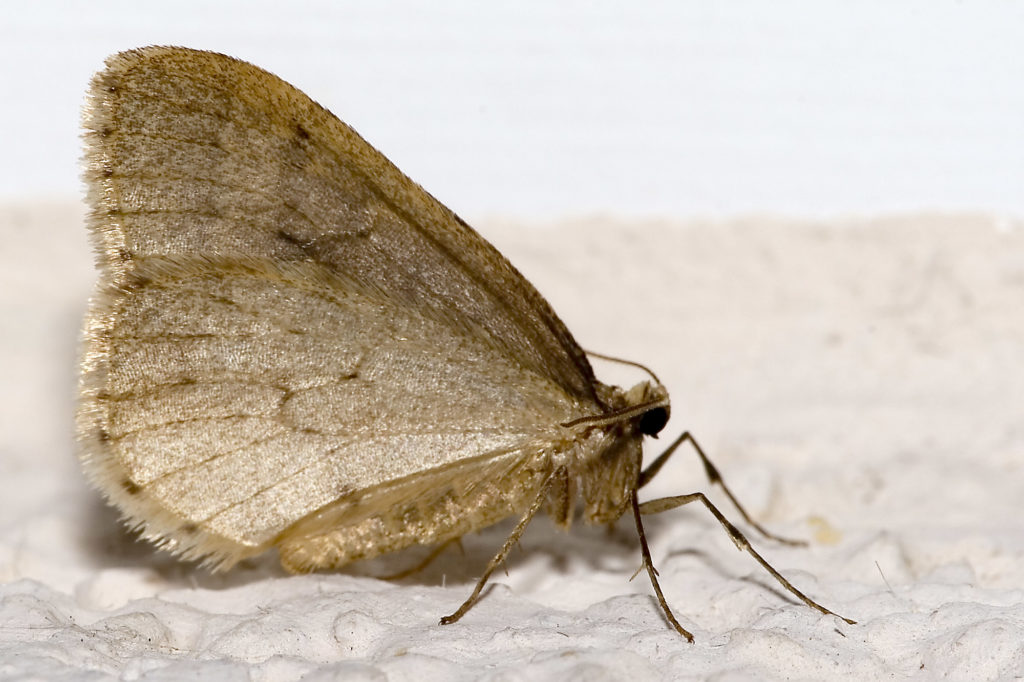Winter moth is a small species of moth native to Europe and Western Asia. It was first discovered in North America in the 1930’s, appearing across various regions of Canada. It is now considered an invasive pest that is capable of defoliating maples, oaks, and other deciduous trees.
Hosts:
Winter moth larvae feed on a wide range of trees. Some of their more common hosts include oaks, maples, cherries, basswood, ash, white elm, spruces, heathers, crabapples, apple trees, and blueberry bushes. Larvae have voracious appetites, and have been known to feed on perennials as well.
Appearance:
Winter moth larvae are pale green caterpillars that can grow up to an inch in length. They have a pair of long white stripes that run down either side of their body, and two sets of prolegs that enable them to navigate across trees, and other plants.
Following pupation, larvae emerge from their coccoons in the form of moths. Male winter moths are larger in frame, and have a light, tan color. They have four elongated wings that encompass their bodies. Each wing is fringed with tiny scales that lend the male a furry appearance. Females are a duller grey color. Their bodies are segmented, and laden with scales. These scales resemble small hairs, which lend females a furry appearance akin to their male counterparts. A set of small wing stubs protrude out from their bodies, but they are incapable of flight.
Life Cycle:
Winter moths begin their mating cycle soon after emerging from pupation. Females emit a pheremone that attracts males for the purpose of mating. After mating, females search for a suitable tree to lay their eggs on. Once they have selected an ideal host, the females settle, and deposit approximately 150 eggs throughout the tree. Soon after, they expire, having completed the final stage of their lives.
Each egg develops over the winter months, finally hatching sometime between late March and mid April. Eggs appear green at first, but acquire a red shade as they develop. In March, they turn a bright blue color, deepening to a darker mixture of blue and black just before they hatch. The eggs hatch once the weather becomes consistently mild, reaching a temperature of 55 °F. As the eggs hatch, larvae emerge in the form of tiny caterpillars, and quickly begin to scale their hosts. The caterpillars scour the tree, searching for fresh buds, and leaves that they can feast on. They wriggle between the bud scales of newly blooming buds, and proceed to devour the flower and foliar buds from within. Once they have finished, the caterpillars migrate to another bud and continue feeding. As the leaf buds open, the caterpillars become exposed, and can be seen feeding within the clusters of new leaves.
Some larvae crawl up the tree and produce a strand of silk that enables them to become air buoyant. They use a dispersal method called ballooning, which allows them to ascend farther into tree canopies.
As they develop, caterpillars will often leave their feeding sites at night, and become free feeders. Free feeders are caterpillars that can move easily from one area to another. They will also drop down, or balloon onto other plants and herbaceous perennials in order to feed.
When the caterpillars have become fully mature, they drop to the soil, and envelop themselves in a soft, wooly coccoon for pupation. Winter moths finish pupation, and emerge from the soil throughout November and December. If temperatures are mild, they may continue to be active into January.
Impact on Trees:
Winter moth larvae wriggle their way into tree buds in early spring just before they bloom. Once inside, they begin to feed, devouring the flower and foliar buds. As the larvae grow, they feed in the expanding leaf clusters, stripping the tree of any new bud growth. Large populations can quickly defoliate trees, resulting in limb or tree failure. The decimation of buds on fruit trees can result in fewer fruit being produced, leading to dimished harvests.
Prevention & Management:
Every spring, have a professional arborist perform a thorough inspection of the leaf buds on any susceptible trees. Any trees that are stressed should be supplemented with water throughout the entire growing season.
For trees that have been impacted by winter moth, there are a number of control methods that can be used to manage their spread:
Chemical compounds and oil sprays can be effective at preventing winter moth. Applying a dormant oil spray to trunks and branches can kill eggs before they hatch. However, depending on their location, some eggs may be shielded from the application. Chemical compounds such as spinosad or carbaryl can be used to contend with newly hatched caterpillars, but they have their drawbacks. Spinosad in particular is effective against winter moth, but it is highly toxic to honey bees. Any chemical compounds that are used should be applied after trees have come into bloom and bees have finished foraging.
Chemical insecticides, such as pyrethroids, are often used to eradicate winter moth, but they can have an adverse effect on other more beneficial organisms as well.
Tree banding involves the installation of a paper or plastic band around the trunk of a tree. The band is covered with a sticky substance that snares caterpillars as they attempt to climb up the tree. A cotton or polyester fiberfill can be placed under the band in order to further discourage passage. These products are not often effective, and can be easily overwhelmed when used on larger populations.
Wasps, beetles, and the tachinid fly are a few of winter moth’s natural predators. When present in an environment, they can lead to an increased mortality rate in winter moth pupae. However, they do not significantly hamper the development of larger populations.
Additional Reading:
https://ag.umass.edu/fact-sheets/winter-moth-overview
Photo courtesy of Kleiner Frostspanner.


